Waterjet cutting is an accelerated erosion process that utilizes highly pressurized water to cut metals and other materials. The high pressure is provided by a high-pressure pump that delivers a supersonic stream of water.
Most commonly, there are pure water jet cutting machines and abrasive waterjet cutting process.
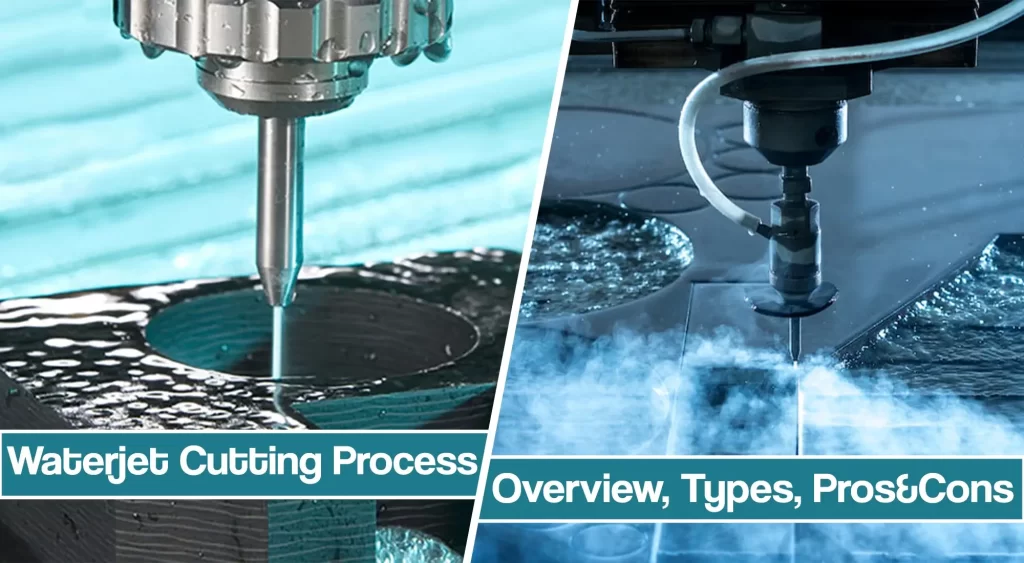
Pure waterjet cutting is used for soft materials such as plastic shapes, wood or rubber, while abrasive waterjet cutting can be used to cut metals such as mild steel, stainless steel, titanium, aluminum, glass, etc.
In this article, we will discuss the waterjet cutting method, types, advantages, and drawbacks.
What Is Waterjet Cutting Process?
The waterjet cutting method is used for cutting objects utilizing the energy from high speed, high density, ultra-high pressure water.
The water in the water jet is pressurized, up to 392 MPa, and projected and pointed using a small precision waterjet nozzle.
As the cutting stream leaves the nozzle, it reaches speeds that are three times the speed of sound.
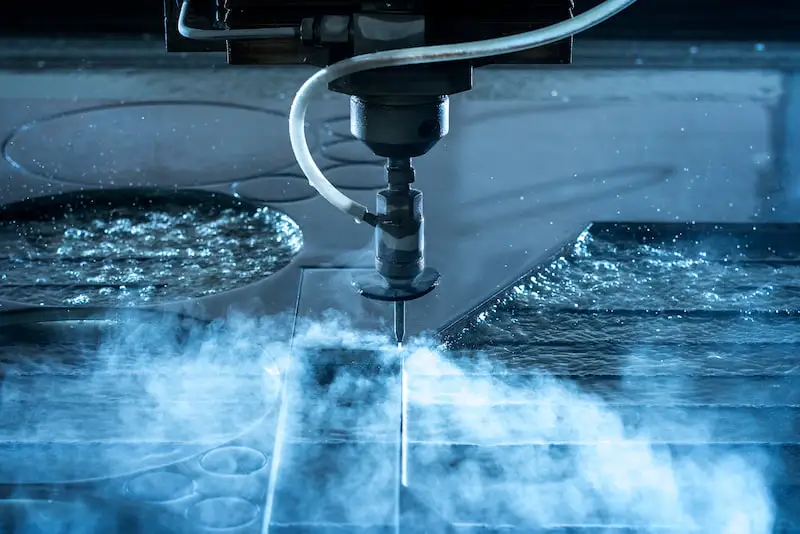
The pressure inside the waterjet cutter creates a vacuum and draws garnet sand into the stream. The sand particles cause the effect of erosion of material being cut, at such a high speed, that it is characterized as cutting.
Waterjet cutting is a quite versatile cutting process, making it useful in various applications. That’s why it found its way into many different projects and the possibility to cut virtually any material, such as cutting roof materials, dashboards, and bumpers for automobiles and cutting and demolition of concrete structures.
You can learn about other metal cutting processes in our in-depth guide, where we cover plasma arc cutting, oxy-fuel cutting, laser cutting, and mechanical cutting methods.
Parts Of a Waterjet Cutting System
Like any other cutting method or welding process, the waterjet cutting system is made of several different parts. Waterjet cutters are quite complex, but highly accurate and efficient cutting systems. Let’s overview the common parts of a system.
Waterjet High-Pressure Pump
Water pressure is essential for the waterjet cutting method. Therefore, the reliable high-pressure pump that produces a high-pressure stream might be the most crucial part of the waterjet system. While there are two types of high-pressure pump, they both consist of a motor, water filters, control systems, and sensors.
- Linear intensifier pumps use pressurized hydraulic oil which is pressurized at 3000 psi. Low-pressure oil pushes against a piston that has a face area that is 20 times larger than that of the high-pressure plunger that pushes against the water. Since the size of the low pressure pump is 20 times larger than that of the high-pressure one, the pressure on the larger plunger is intensified 20 times, yielding a pressure of 60,000 psi.
- A direct drive pump works much like a car engine, forcing water through high-pressure tubing using plungers attached to a crankshaft. It has an electric motor that rotates a crank that drives pistons that generate the water pressure. Direct drive pumps have 30-hp motors with an inlet that supplies water to the pump.
High-pressure Tubing
After the pump pressurizes the water, it is later supplied through tubing to the cutting head. Tubing has excellent yield and tensile strength with a smooth interior surface. It is produced from cold-worked stainless steel or thermoplastic pressure hose in sizes from 0.25 inches up to 0.563 inches. The tubing comes in a wide variety of lengths to fit the design of the water jet cutter.
Waterjet Cutting Head
The pressurized water passes through the tubing at it is supplied into the cutting head, which is a diamond, ruby, or sapphire. The head has a hole smaller than the point of a pin.
As the water passes through the head, its velocity increases to over 90,000 psi or 2500 mph. As a result, the cutting capability is directly affected by the power provided by the cutting head.
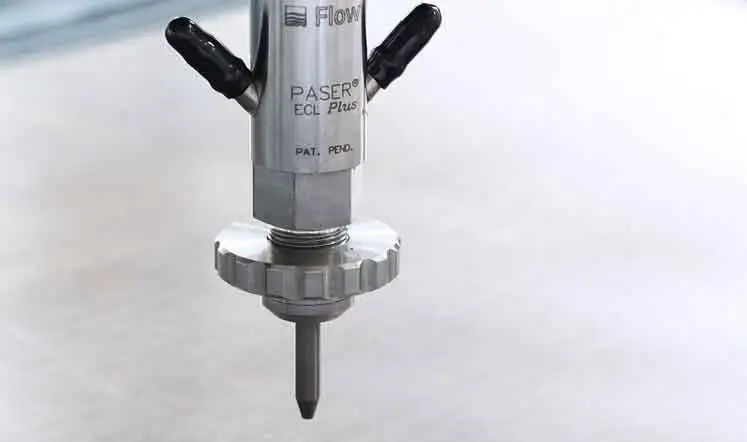
After passing through cutting heat, the high-pressure water is focused into a beam by a nozzle. The cutting nozzle uses the configuration of a mixing chamber and a tube to allow for the abrasive to carefully mix to provide efficient cutting by jet stream. Waterjet nozzles are also designed without the abrasive mixing chamber and tube, so it fires high-pressure water, which would be used to cut much softer materials.
Types of Waterjet Cutting Methods
Water jet cutting can differ in several different matters. Water jet cutting machines can be programmed to perform a wide variety of cuts. They are capable of performing traditional single cuts, but the industrial cutting device can utilize 2, 3, 4, and 5-axis cuts in the manufacturing process.
One of the significant differences is between traditional, pure waterjet cutting and abrasive jet machining.
Pure Waterjet Cutting
Pure water jet cutters are the traditional type of water jet cutting tool. This type of waterjet cutting doesn’t have the addition of abrasive particles. In this case, it is the pressure and speed of the water itself which penetrates the material.
They create less moisture on the surface of the workpiece than is created by touching it. Pure waterjet system has a thin stream that cuts excellent detailed geometries with limited material loss.
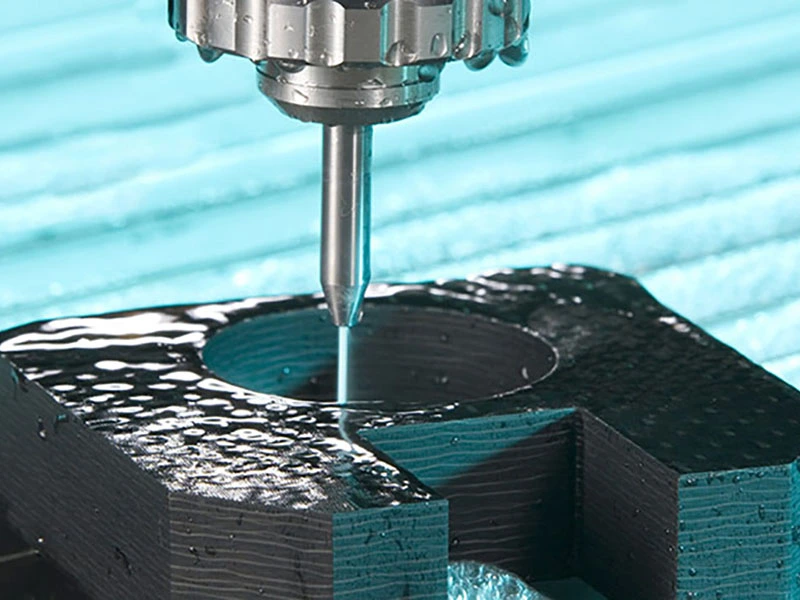
The construction of a pure water jet cutter has a jewel with rubies being excluded and unsuitable for work with pure water. The stream travels at Mach 2 for 40,000 psi and Mach 3 for 60,000 psi. Pure waterjet cutting is ideal for soft materials like fabrics,rubber, or metal foils.
Abrasive Waterjet Cutting
In an abrasive waterjet cutting, an abrasive particle (e.g. garnet) is added to high-pressure water, making it easier to cut through hard materials.
The abrasive particle is fed into the nozzle of a waterjet cutting machine. Therefore, the abrasive particle does the work of cutting the material, while the water accelerates the abrasive particle. As a result, abrasive particles reach the speed required to cut even thicker materials.
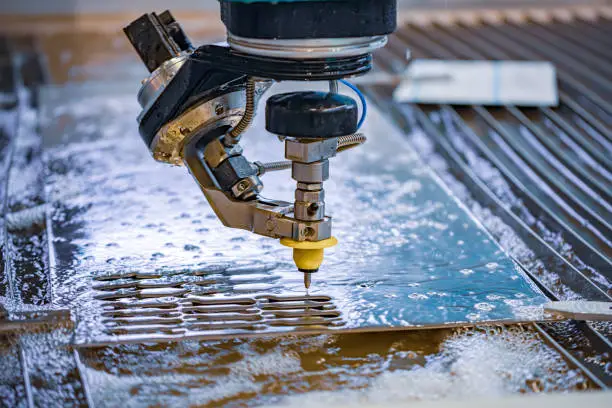
By improving the water pressure, cutting capability is improved. Therefore, by accelerating the water and particles, or increasing the flow rate of water, the water jet cutting machine can cut thicker materials with minimal material waste. Abrasive waterjet cutting is ideal for harder or thicker materials like metals, stones, or thick plastics.
Advantages and Drawbacks of Waterjet cutting
Advantages
- Cold cutting process: since there are no heat-affected zones, the risk of material distortion is minimal, even with thin materials.
- Extremely accurate: cutting accuracy between ± 0.003 inch to ± 0.005 inch makes it suitable for complex shapes. In addition, cutting speed can be altered mid-cut.
- Versatile process: waterjet technology can be used to cut any material regardless of its hardness and material thickness. Commonly, waterjet cut can be used to produce turbine blades, nameplates, gear, electric guitar bodies, etc.
- Easy to program: waterjet cutting can be easily implemented into computer numerical control (CNC machining).
- Easy to operate: the skill required to operate waterjet cutting machines and motion control systems is quite low.
- Safe: waterjet machine doesn’t produce any fumes or spark, so it is safe for operators.
Drawbacks
- Part wear: abrasive material can cause nozzle degradation, meaning there is a need for maintenance.
- Lower cutting speed: in certain applications, waterjet cutting is slower compared to the laser cutting process. In a large-scale manufacturing process, low cost initially can be reduced by lower cutting speed.
- Produced dust: Waterjet cutters produce dust that can damage the equipment and cause certain environmental issues when discarded.






